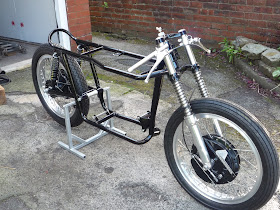As information on the Potts desmo filtered out to other racers and the press, much anticipation started to build about the project. In Geoff Duke’s preview to the 1958 season, he wrote the following:
“With rumour upon rumour circulating about the Joe Potts’ stable, and all sorts of items, from the 270 lb “500s” to 90mm bores and desmodromic valve gears being accepted facts, one can hardly discount Bob McIntyre’s chances.”
The Editor of Motorcycling magazine went to visit the team at Bellshill before the start to the season. He concluded his article with the following:
Progress had been slower on the Potts desmo than anticipated, so it was not ready for the start of the season. At this point the cambox had been part-machined, but all the bearings had been fitted. Three sets of rockers for the desmo had also been made (for 250cc, 350cc and 500cc engines).
The rolling chassis for the 350cc and 500cc had been manufactured. So for the start of the 1958 season Bob Mcintyre would race these machines with more conventional Manx Norton engines. The 500cc machine scaled in at a very lightweight 274lbs. It should be noted that for the initial development, conventional Manx Norton wheels were utilised instead of the Gilera wheels.
Whilst Bob raced the lightweight 350cc and 500cc Manxes, the team at Bellshill would continue to develop the desmodromic valve gear so that it could be used later in the season. The more conventional engines that Bob used in his Manxes were still far from standard.
 |
| Bob's 270lb 500cc Razorblade Potts Manx |
For fitting into Bob Mac’s Razorblade frames the team had been working on new 500cc and 350cc Manx engines. These two engines were completely Potts work using only the crankcases, timing case, cam drive assembly and cambox from a Manx Norton. The 500cc engine was to be 90mm bore and 78mm stroke. The 350cc engine had an 80mm bore and 69.5mm stroke. The crank assembly for both these engines was made at Bellshill. The flywheels were machined by Potts from blank forgings and were oval in shape to allow the use of ultra-short connecting rods. The flywheels had integral mainshafts and a flanged crankpin was pressed into the drive-side wheel before being drawn into the timing-side by a nut that was subsequently cut away. A specially commissioned big-end made by Alpha bearings was used, which incorporated two more rollers, all of a smaller diameter (14 rollers as opposed to 12). This was done to reduce skidding of the rollers at very high engine speeds. The short con-rods were also machined at Bellshill from solid steel billets. Special pistons for the engines were also machined at Bellshill which featured very short skirts to help clear the flywheels and reduce friction. Blank cylinder heads were machined to allow the use of larger valves (2 inch inlet valve on the 500cc) and a more down-draft intake port. Due to the greater down-draft intake port, a specially modified Amal GP1 carburettor had to be used to prevent flooding. The cams in the engines were Bellshill made specials, drawn up by Charlie Bruce.
More to follow




